人教版(2019)选择性必修第二册Unit 5 First Aid Discover Useful Structures 语法课件(共23张PPT)
文档属性
| 名称 | 人教版(2019)选择性必修第二册Unit 5 First Aid Discover Useful Structures 语法课件(共23张PPT) | 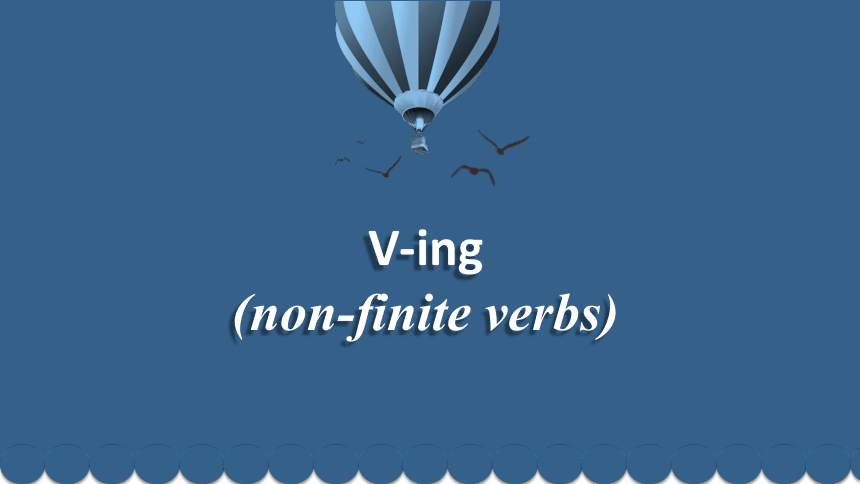 | |
| 格式 | pptx | ||
| 文件大小 | 444.8KB | ||
| 资源类型 | 教案 | ||
| 版本资源 | 人教版(2019) | ||
| 科目 | 英语 | ||
| 更新时间 | 2024-01-12 11:06:10 | ||
图片预览

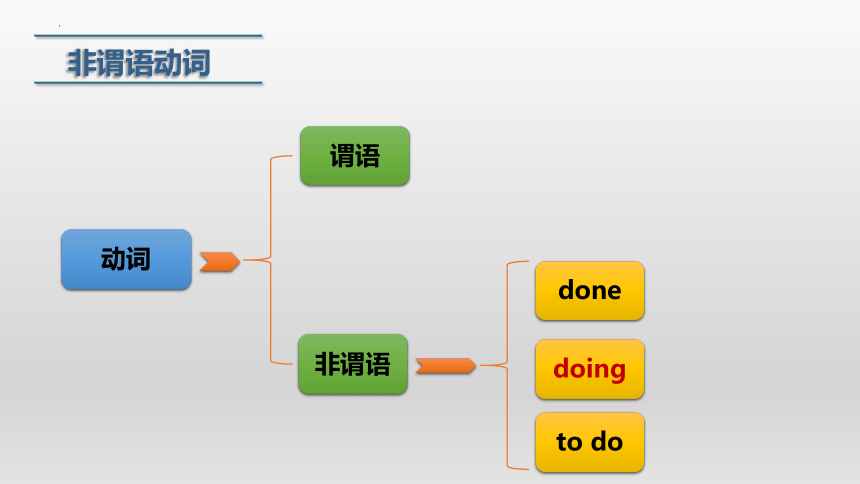

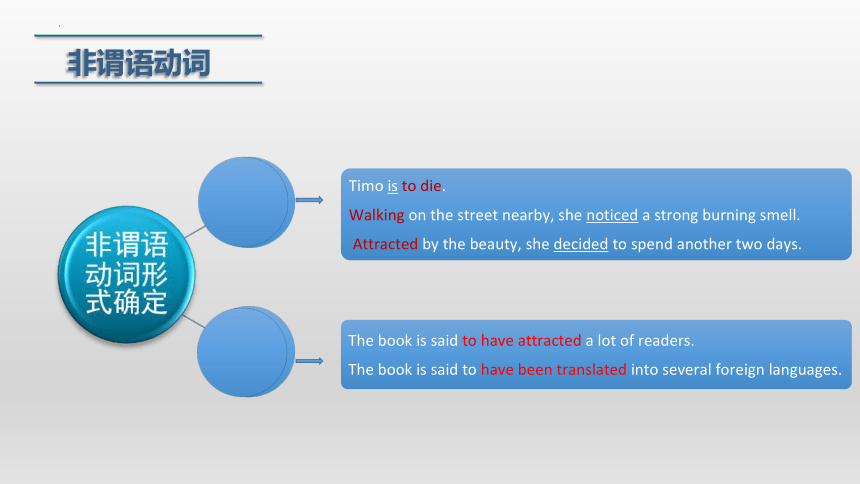
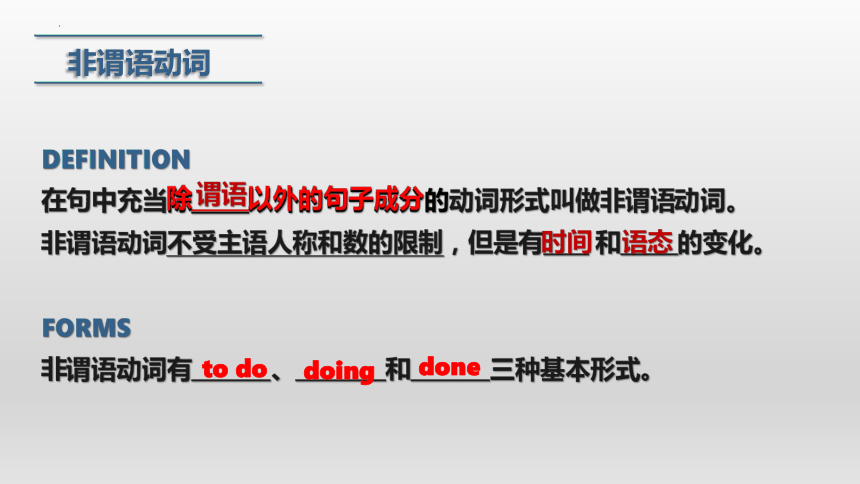
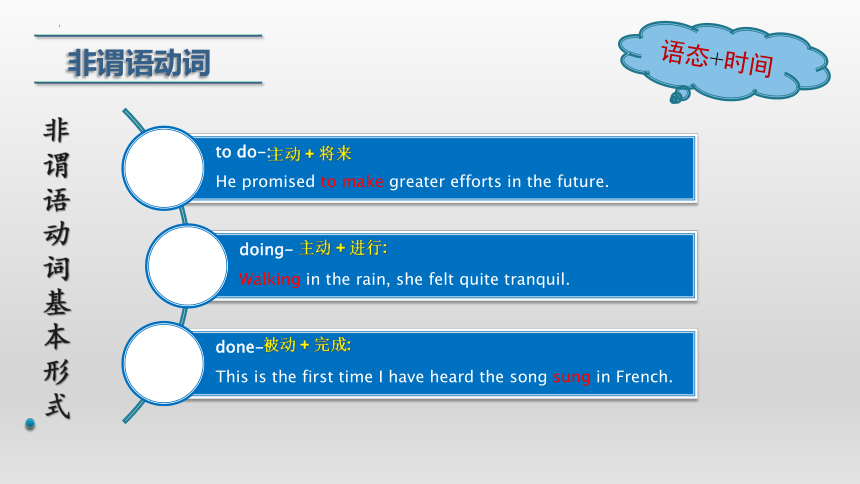
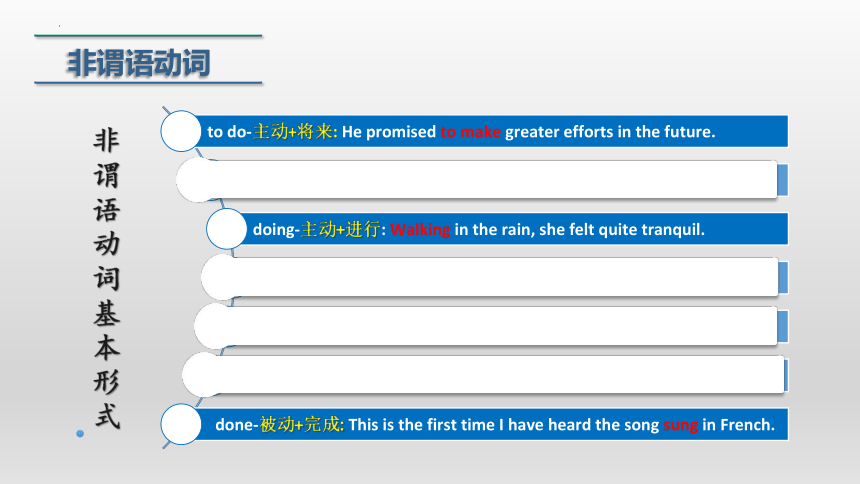
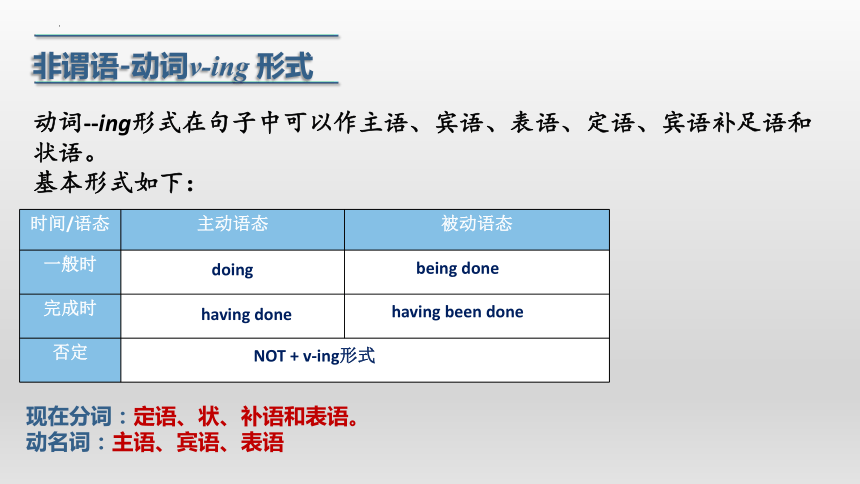

文档简介
(共23张PPT)
V-ing
(non-finite verbs)
非谓语动词
动词
谓语
非谓语
done
doing
to do
谓语动词
If I were you, I would not accept the invitation.
非谓语动词
非谓语动词
DEFINITION
在句中充当除_____以外的句子成分的动词形式叫做非谓语动词。
非谓语动词不受主语人称和数的限制,但是有____ 和_____的变化。
FORMS
非谓语动词有_______、________和_______三种基本形式。
谓语
时间
语态
to do
doing
done
除_____以外的句子成分
非谓语动词
语态+时间
主动 + 将来
主动 + 进行:
被动 + 完成:
非谓语动词
非谓语-动词v-ing 形式
现在分词:定语、状、补语和表语。
动名词:主语、宾语、表语
时间/语态 主动语态 被动语态
一般时
完成时
否定
doing
being done
having done
having been done
NOT + v-ing形式
动词- ing形式在句子中可以作主语、宾语、表语、定语、宾语补足语和状语。
基本形式如下:
1. 作主语、宾语、表语、定语
V-ing
non-finite verbs
2. 作定语、状语、补语、表语
【总结归纳】
1. 单个动词v-ing 形式做主语,谓语动词通常用单数形式;
动词v-ing 形式做主语的位置:句首/句尾
动词v-ing作主语
1. _________(build) up a team is more complex than simply hiring the best talent.
2. It is no use ________(cry) over split milk.
3. _______(sing) is my hobby, and ________ (sing) at the concert is my dream.
4. _____________(blame) for the breakdown of the computer made me quite frustrated.
Building
crying
Singing
to sing
【总结归纳】
it 作形式主语,真正主语是后面的动名词,主要用于下列句型中:
It be no use/useless doing... 做……无用
It be no good/pleasure/fun doing... 做……无好处 / 乐趣
It be a waste of time doing... 做……浪费时间
It is worth doing … 做某事是值得的
Being blamed
动名词作主语与不定式做主语的区别:
动名词作主语往往表示经常性、习惯性或抽象的一般性行为。
不定式作主语往往表示具体的特别是将来的动作。
动词v-ing作主语
1. v-ing的复合结构:非谓语动词有时需要添加自己的逻辑主语,通常有两种形式:
形容词性物主代词+动词-ing
名词所有格+动词-ing
2.动名词作主语与不定式做主语的区别:
动名词作主语往往表示经常性、习惯性或抽象的一般性行为。
不定式作主语往往表示具体的特别是将来的动作。
他们前来帮忙对我们来说是巨大的鼓舞。
Their coming to help was a great encouragement to us.
Lily前来帮忙对我们来说是巨大的鼓舞。
Lily’s coming to help was a great encouragement to us.
动词v-ing作宾语
1. People favor shaking hands, bowing from the waist, or nodding the head when they meet someone else.
2. One never loses by doing a good turn.
3. He narrowly avoided _____________ (kill) in the accident
4. I am looking forward to ______________ (admit) to a key university.
动词-ing 作宾语时,可位于及物动词后(动宾),
也可位于介词后(介宾)
being killed
being admitted
动词v-ing作宾语
1. 常接动词-ing形式作宾语的动词:
avoid, miss, postpone, advise, finish, practice, enjoy, imagine, can't help, admit, deny, envy, escape, risk, excuse, stand, keep, mind…
2.常用动词-ing形式作介词的宾语:
insist on, object to, be good at, be fond of, lead to, put off, give up, look forward to, feel like, devote to, get used to, pay attention to…
3.在有些动词的后面,如 start, begin, continue, prefer 等既可接动词-ing形式也可接不定式作宾语,两者意义区别不大。
They continued working/to work as if nothing had happened.
动词v-ing作宾语
4.有些动词或动词短语后跟动词-ing形式或不定式都可以,但意思不同。接不定式一般表示动作尚未发生,而接动名词则表示动作已经发生。
remember/ forget to do. . . 记着/忘记要做……
remember/forget doing. . . 记着/忘记做过……
regret to do. . . 遗憾要做……
regret doing. . . 后悔做了……
mean to do. . . 打算做……
mean doing. . . 意味着……
动词v-ing作宾语
5. need, require, want(作“需要”讲时), deserve ,接动词-ing 形式作宾语,相当于不定式的被动形式 -主动形式表被动意义:
主语+want/need/require/deserve +doing/ to be done 主语需要被……
My shirt needs washing.
=My shirt needs to be washed.
动词v-ing作宾语
6. 在以下结构中,动词-ing形式作介词的宾语,介词常省略。
spend...(in) doing sth花费……做某事
have difficulty/trouble (in) doing...做……有困难/麻烦
stop/prevent...(from) doing sth阻止……做某事
waste time (in) doing sth浪费时间做某事
be busy (in) doing sth忙于做某事
have a good/hard time (in) doing sth做某事很愉快/费了很大劲做某事
There is no point/sense (in) doing sth做某事毫无意义
动词v-ing作表语
1. Her job is keeping the lecture hall as clean as possible.
2. Landing one the moon’s far side is extremely ___________(challenge).
3. Tony's hobby is ______(draw), but now what he wants to do is_____(dance).
动名词和现在分词都可以作表语,但有所区别。
动名词作表语,表示抽象性/习惯性动作,用来说明主语的内容或者某种性质或特征,主语和表语可以换位;
现在分词作表语,说明主语性质、特征。这类动词-ing形式通常可以看作形容词;主语和表语不可换位。
*动词-ing形式作表语表示抽象的一般性的行为,而不定式作表语表示一次具体的动作或将要发生的事。
=Keeping the lecture hall as clean as possible is her job.
challenging
drawing
to dance
动词v-ing作宾补
1. Remove any clothes if necessary unless you see the fabric ________(stick) to the burnt skin.
2. I felt somebody _________(stand) behind me.
动词-ing形式作宾语补足语时,表示正在进行的动作或经常存在的状态。
1. 常见的感官动词(短语)有:see,hear,feel,smell,find,notice,observe,look at,listen to。常用结构为“感官动词+宾语+宾补”。
sticking
standing
动词v-ing作宾补
1. We kept the fire ________(burn) all night long.
2. I won’t have you ________(run) about in the room.
3. I won’t let you ______(lie) to others.
4. Online shopping can get you ___________(addict) to it.
2. 使役动词的常见结构有:
① have/keep/get/leave sb/sth+doing sth 使……一直做某事
② have/let/make sb+do sth使/让某人做某事
③get/cause sb to do sth 使/让某人做某事
burning
running
lie
to be addicted
动词v-ing作宾补
1. With heavy smoke ______(fill) the house,it was nearly impossible for him to see the surroundings
2. With my proposal ________(decline),I was in low spirits.
3. With so much work _________(do),he was nearly in despair.
3. with的复合结构的常见用法如下:
with+宾语+doing(表示主动或进行)
with+宾语+done(表示被动或完成)
with+宾语+to do(表示将来)
filling
declined
to do
动词v-ing作定语
No one is allowed to speak aloud in the reading room.
The national park has a large collection of wildlife ________(range) from butterflies to elephants.
The meeting ___________(hold) now is of great significance.
=The meeting which/that ______________ now is of great significance.
动词V-ing形式作定语:
① 说明被修饰词的属性或者某种用途,意为“供….用”,相当于介词for短语:the reading room=the room for reading;
②表示被修饰词的动作或状态,它和被修饰词之间有逻辑上的主动关系,相当于一个定语从句:a singing bird = a bird that is singing
ranging
…a large collection of wildlife, which ranges from butterflies to elephants.
being held
is being held
动词v-ing作状语
1. she saw an old friend.
= she saw an old friend.
= she saw an old friend.
2. he couldn’t go to school.
= he couldn’t go to school.
动词-ing形式作状语可表示时间、原因、条件、让步、结果、方式或伴随等,来修饰谓语动词或整个句子;
*为表意更明确可在其前加上相应的连词,如when,while,though,构成从属连词+非谓语(-v-ing/v-ed的形式);
*可以转换成相应的状语从句或并列句中的一个分句。
When walking in the park,
Being ill,
When she was walking in the park,
Walking in the park,
Because/Since/As he was ill,
动词v-ing作状语
I murmured sorry, reflecting that I should have taken his warning seriously.
= I murmured sorry and reflected that I should have taken his warning seriously
2. The hospital has recently obtained new medical equipment,________(allow) more patients to be treated.
3. He lifted the stone only ______(drop) it on his own feet.
*并列谓语动词与伴随或者方式状语:
若有and连接两个并列的谓语动词,(谓语动词的动作(几乎)同时发生), 此时可以将其中一个谓语动词降级成为非谓,表示方式或伴随状语。
*非谓语作结果状语:
①表示必然的结果:(thus) + v-ing; 常常位于句末;
②表示一种出乎意料的结果:only +to do
allowing
to drop
V-ing
(non-finite verbs)
非谓语动词
动词
谓语
非谓语
done
doing
to do
谓语动词
If I were you, I would not accept the invitation.
非谓语动词
非谓语动词
DEFINITION
在句中充当除_____以外的句子成分的动词形式叫做非谓语动词。
非谓语动词不受主语人称和数的限制,但是有____ 和_____的变化。
FORMS
非谓语动词有_______、________和_______三种基本形式。
谓语
时间
语态
to do
doing
done
除_____以外的句子成分
非谓语动词
语态+时间
主动 + 将来
主动 + 进行:
被动 + 完成:
非谓语动词
非谓语-动词v-ing 形式
现在分词:定语、状、补语和表语。
动名词:主语、宾语、表语
时间/语态 主动语态 被动语态
一般时
完成时
否定
doing
being done
having done
having been done
NOT + v-ing形式
动词- ing形式在句子中可以作主语、宾语、表语、定语、宾语补足语和状语。
基本形式如下:
1. 作主语、宾语、表语、定语
V-ing
non-finite verbs
2. 作定语、状语、补语、表语
【总结归纳】
1. 单个动词v-ing 形式做主语,谓语动词通常用单数形式;
动词v-ing 形式做主语的位置:句首/句尾
动词v-ing作主语
1. _________(build) up a team is more complex than simply hiring the best talent.
2. It is no use ________(cry) over split milk.
3. _______(sing) is my hobby, and ________ (sing) at the concert is my dream.
4. _____________(blame) for the breakdown of the computer made me quite frustrated.
Building
crying
Singing
to sing
【总结归纳】
it 作形式主语,真正主语是后面的动名词,主要用于下列句型中:
It be no use/useless doing... 做……无用
It be no good/pleasure/fun doing... 做……无好处 / 乐趣
It be a waste of time doing... 做……浪费时间
It is worth doing … 做某事是值得的
Being blamed
动名词作主语与不定式做主语的区别:
动名词作主语往往表示经常性、习惯性或抽象的一般性行为。
不定式作主语往往表示具体的特别是将来的动作。
动词v-ing作主语
1. v-ing的复合结构:非谓语动词有时需要添加自己的逻辑主语,通常有两种形式:
形容词性物主代词+动词-ing
名词所有格+动词-ing
2.动名词作主语与不定式做主语的区别:
动名词作主语往往表示经常性、习惯性或抽象的一般性行为。
不定式作主语往往表示具体的特别是将来的动作。
他们前来帮忙对我们来说是巨大的鼓舞。
Their coming to help was a great encouragement to us.
Lily前来帮忙对我们来说是巨大的鼓舞。
Lily’s coming to help was a great encouragement to us.
动词v-ing作宾语
1. People favor shaking hands, bowing from the waist, or nodding the head when they meet someone else.
2. One never loses by doing a good turn.
3. He narrowly avoided _____________ (kill) in the accident
4. I am looking forward to ______________ (admit) to a key university.
动词-ing 作宾语时,可位于及物动词后(动宾),
也可位于介词后(介宾)
being killed
being admitted
动词v-ing作宾语
1. 常接动词-ing形式作宾语的动词:
avoid, miss, postpone, advise, finish, practice, enjoy, imagine, can't help, admit, deny, envy, escape, risk, excuse, stand, keep, mind…
2.常用动词-ing形式作介词的宾语:
insist on, object to, be good at, be fond of, lead to, put off, give up, look forward to, feel like, devote to, get used to, pay attention to…
3.在有些动词的后面,如 start, begin, continue, prefer 等既可接动词-ing形式也可接不定式作宾语,两者意义区别不大。
They continued working/to work as if nothing had happened.
动词v-ing作宾语
4.有些动词或动词短语后跟动词-ing形式或不定式都可以,但意思不同。接不定式一般表示动作尚未发生,而接动名词则表示动作已经发生。
remember/ forget to do. . . 记着/忘记要做……
remember/forget doing. . . 记着/忘记做过……
regret to do. . . 遗憾要做……
regret doing. . . 后悔做了……
mean to do. . . 打算做……
mean doing. . . 意味着……
动词v-ing作宾语
5. need, require, want(作“需要”讲时), deserve ,接动词-ing 形式作宾语,相当于不定式的被动形式 -主动形式表被动意义:
主语+want/need/require/deserve +doing/ to be done 主语需要被……
My shirt needs washing.
=My shirt needs to be washed.
动词v-ing作宾语
6. 在以下结构中,动词-ing形式作介词的宾语,介词常省略。
spend...(in) doing sth花费……做某事
have difficulty/trouble (in) doing...做……有困难/麻烦
stop/prevent...(from) doing sth阻止……做某事
waste time (in) doing sth浪费时间做某事
be busy (in) doing sth忙于做某事
have a good/hard time (in) doing sth做某事很愉快/费了很大劲做某事
There is no point/sense (in) doing sth做某事毫无意义
动词v-ing作表语
1. Her job is keeping the lecture hall as clean as possible.
2. Landing one the moon’s far side is extremely ___________(challenge).
3. Tony's hobby is ______(draw), but now what he wants to do is_____(dance).
动名词和现在分词都可以作表语,但有所区别。
动名词作表语,表示抽象性/习惯性动作,用来说明主语的内容或者某种性质或特征,主语和表语可以换位;
现在分词作表语,说明主语性质、特征。这类动词-ing形式通常可以看作形容词;主语和表语不可换位。
*动词-ing形式作表语表示抽象的一般性的行为,而不定式作表语表示一次具体的动作或将要发生的事。
=Keeping the lecture hall as clean as possible is her job.
challenging
drawing
to dance
动词v-ing作宾补
1. Remove any clothes if necessary unless you see the fabric ________(stick) to the burnt skin.
2. I felt somebody _________(stand) behind me.
动词-ing形式作宾语补足语时,表示正在进行的动作或经常存在的状态。
1. 常见的感官动词(短语)有:see,hear,feel,smell,find,notice,observe,look at,listen to。常用结构为“感官动词+宾语+宾补”。
sticking
standing
动词v-ing作宾补
1. We kept the fire ________(burn) all night long.
2. I won’t have you ________(run) about in the room.
3. I won’t let you ______(lie) to others.
4. Online shopping can get you ___________(addict) to it.
2. 使役动词的常见结构有:
① have/keep/get/leave sb/sth+doing sth 使……一直做某事
② have/let/make sb+do sth使/让某人做某事
③get/cause sb to do sth 使/让某人做某事
burning
running
lie
to be addicted
动词v-ing作宾补
1. With heavy smoke ______(fill) the house,it was nearly impossible for him to see the surroundings
2. With my proposal ________(decline),I was in low spirits.
3. With so much work _________(do),he was nearly in despair.
3. with的复合结构的常见用法如下:
with+宾语+doing(表示主动或进行)
with+宾语+done(表示被动或完成)
with+宾语+to do(表示将来)
filling
declined
to do
动词v-ing作定语
No one is allowed to speak aloud in the reading room.
The national park has a large collection of wildlife ________(range) from butterflies to elephants.
The meeting ___________(hold) now is of great significance.
=The meeting which/that ______________ now is of great significance.
动词V-ing形式作定语:
① 说明被修饰词的属性或者某种用途,意为“供….用”,相当于介词for短语:the reading room=the room for reading;
②表示被修饰词的动作或状态,它和被修饰词之间有逻辑上的主动关系,相当于一个定语从句:a singing bird = a bird that is singing
ranging
…a large collection of wildlife, which ranges from butterflies to elephants.
being held
is being held
动词v-ing作状语
1. she saw an old friend.
= she saw an old friend.
= she saw an old friend.
2. he couldn’t go to school.
= he couldn’t go to school.
动词-ing形式作状语可表示时间、原因、条件、让步、结果、方式或伴随等,来修饰谓语动词或整个句子;
*为表意更明确可在其前加上相应的连词,如when,while,though,构成从属连词+非谓语(-v-ing/v-ed的形式);
*可以转换成相应的状语从句或并列句中的一个分句。
When walking in the park,
Being ill,
When she was walking in the park,
Walking in the park,
Because/Since/As he was ill,
动词v-ing作状语
I murmured sorry, reflecting that I should have taken his warning seriously.
= I murmured sorry and reflected that I should have taken his warning seriously
2. The hospital has recently obtained new medical equipment,________(allow) more patients to be treated.
3. He lifted the stone only ______(drop) it on his own feet.
*并列谓语动词与伴随或者方式状语:
若有and连接两个并列的谓语动词,(谓语动词的动作(几乎)同时发生), 此时可以将其中一个谓语动词降级成为非谓,表示方式或伴随状语。
*非谓语作结果状语:
①表示必然的结果:(thus) + v-ing; 常常位于句末;
②表示一种出乎意料的结果:only +to do
allowing
to drop
